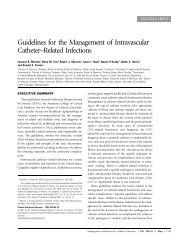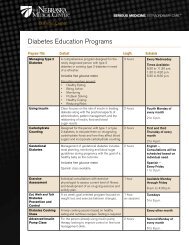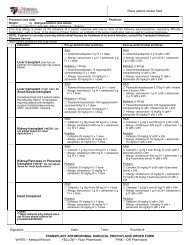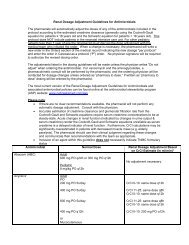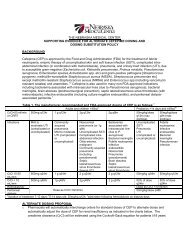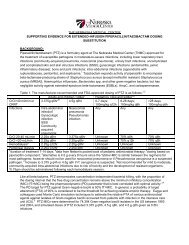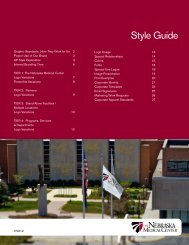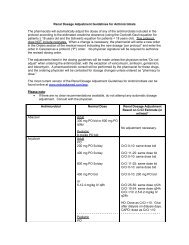Piperacillin/tazobactam Dosing Protocol - The Nebraska Medical ...
Piperacillin/tazobactam Dosing Protocol - The Nebraska Medical ...
Piperacillin/tazobactam Dosing Protocol - The Nebraska Medical ...
You also want an ePaper? Increase the reach of your titles
YUMPU automatically turns print PDFs into web optimized ePapers that Google loves.
THE NEBRASKA MEDICAL CENTER<br />
SUPPORTING EVIDENCE FOR EXTENDED-INFUSION PIPERACILLIN/TAZOBACTAM DOSING<br />
SUBSTITUTION<br />
BACKGROUND:<br />
<strong>Piperacillin</strong>/<strong>tazobactam</strong> (PTZ) is a formulary agent at <strong>The</strong> <strong>Nebraska</strong> <strong>Medical</strong> Center (TNMC) approved for<br />
the treatment of susceptible pathogens in moderate-to-severe infections, including lower respiratory tract<br />
infections (community-acquired pneumonia, nosocomial pneumonia); urinary tract infections; uncomplicated<br />
and complicated skin and skin structure infections (SSSI); gynecologic infections (endometritis, pelvic<br />
inflammatory disease); bone and joint infections; intra-abdominal infections (appendicitis with<br />
rupture/abscess, peritonitis); and septicemia. 1 Tazobactam expands activity of piperacillin to encompass<br />
beta-lactamase-producing strains of Staphylococcus aureus [except methicillin resistant Staphylococcus<br />
aureus (MRSA)], Haemophilus influenzae, Bacteroides spp, and other gram-negative bacteria; but has<br />
negligible activity against extended-spectrum beta-lactamases (ESBLs), AmpC, and carbapenemases.<br />
Table 1. <strong>The</strong> manufacturer-recommended and FDA-approved dosing of PTZ is as follows: 1,2<br />
CrCl>40 ml/min or<br />
CRRT<br />
Infections<br />
Adults and children >40kg a Pediatrics >2kg and ≤40kg abc<br />
3.375g q6hr de 4.5g q6hr 0-7 days; 8-28 days; >28 days<br />
100mg/kg 100mg/kg q8h 100mg/kg q6h<br />
q12h<br />
Intra-abdominal Nosocomial Any Any Any<br />
infection f pneumonia<br />
Gynecologic Pseudomonas<br />
infection infection<br />
SSSI<br />
Community<br />
acquired<br />
pneumonia<br />
CrCl 20-40 mL/min 2.25g q6hr 3.375g q6hr Unknown 70% q8h 70% q6h<br />
CrCl MIC is similar between<br />
the regimens for most pathogens; however should not be used for nosocomial pneumonia or if Pseudomonas<br />
aeruginosa is a suspected pathogen. e Increase to 3.375 g q4h or 4.5g q6h if P. aeruginosa is suspected. f Not<br />
recommended for mild to moderate, community-acquired intra-abdominal infections due to risk of toxicity and<br />
the development of resistant organisms. g 0.75gm should be administered following each hemodialysis session.<br />
Like all beta-lactams, PTZ demonstrates concentration-independent bacterial killing, with the proportion of<br />
the dosing interval that the free drug concentration remains above the minimum inhibitory concentration<br />
(MIC) (fT>MIC) being the pharmacodynamic (PD) parameter that is best correlated with optimal activity. 3,4<br />
<strong>The</strong> PD target for PTZ against Gram-negative bacilli is 50% fT>MIC. In general, a probability of target<br />
attainment (PTA) of 90% is considered to be the threshold for achieving reliable empiric therapy. Eagye and<br />
colleagues used Monte Carlo simulation techniques to estimate the relative PTA of various antimicrobial<br />
agents against isolates of Gram-negative bacilli recovered from patients with infection in the intensive care<br />
unit (ICU). 5 PTZ MICs were determined for 74,394 Gram-negative bacilli isolates in the US between 1993<br />
and 2004, and simulated doses of PTZ included 3.375 g q6h, 4.5 g q8h, and 4.5 g q6h given as 0.5hr<br />
infusions.
Table 2: Probability of Target Attainment for Various Doses of PTZ with 0.5hr Infusions Against Gram-<br />
Negative Bacilli<br />
Dose<br />
PTA for 50% fT>MIC<br />
1996–1998 1999–2001 2002–2004 p-value<br />
P. aeruginosa<br />
PTZ 3.375 g q6h 75.9 74 73.3 0.0024<br />
PTZ 4.5 g q8h 70.8 69 68.4 0.0095<br />
PTZ 4.5 g q6h 79.6 77.5 76.7 0.0004<br />
Acinetobacter spp.<br />
PTZ 3.375 g q6h 56.4 51.3 43.6 40kg: 6-10<br />
Clcr(ml/min) ≥20ml/min 40kg<br />
CRRT = continuous renal replacement therapy; SLED = slow extended dialysis. Note: Dosage substitution to<br />
4.5g applies to ALL ordered doses of PTZ<br />
Table 4. PTZ Doses for pediatric patients >2kg and ≤40kg will be substituted as follows*:<br />
Age Medication Ordered Interchange With<br />
0-7 days <strong>Piperacillin</strong>/Tazobactam 112.5mg/kg q12hr <strong>Piperacillin</strong>/Tazobactam 112.5mg/kg<br />
q12hr (4 hr infusion)**<br />
8-28 days <strong>Piperacillin</strong>/Tazobactam 112.5mg/kg q8hr <strong>Piperacillin</strong>/Tazobactam 112.5mg/kg<br />
q8hr (4 hr infusion)**<br />
>28 days <strong>Piperacillin</strong>/Tazobactam 112.5mg/kg q6hr <strong>Piperacillin</strong>/Tazobactam 112.5mg/kg<br />
q6hr (4 hr infusion)**<br />
Doses are based on combined product. * Extended infusion not applicable to NICU patients. **Adjust<br />
doses for renal function based on TNMC renal adjustment protocol and infuse over 4 hours.<br />
Renal <strong>Dosing</strong> Adjustment for Pediatric Patients all ages 40ml/min = no adjustment<br />
• CrCl ≤ 40ml/min = decrease original dose 30%<br />
• CrCl ≤ 20ml/min (including peritoneal and hemodialysis) = decrease original dose 30%, infuse q12h<br />
over 4 hours<br />
• CRRT/SLED = dose per normal renal function based on age and weight
JUSTIFICATION:<br />
Internal MIC Surveillance<br />
An internal study was conducted to review the MICs of PTZ against Pseudomonas aeruginosa isolates. A<br />
random selection of 30 blood isolates and 12 sputum isolates were evaluated, and MICs were obtained via<br />
Sensititre susceptibility plates. According to Clinical Laboratory Standards Institute (CLSI) guidelines, the<br />
breakpoint for susceptibility of Enterobacteriaceae and Acinetobacter spp. to PTZ is ≤ 16 mg/L, and<br />
≤64mg/L, for P. aeruginosa. <strong>The</strong> results of the internal survey are illustrated below:<br />
PTZ<br />
MIC 50 8 mg/L<br />
MIC 90 >64 mg/L<br />
<strong>The</strong> data revealed reduced susceptibility of P. aeruginosa isolates to PTZ and are striking for an MIC 90<br />
beyond the susceptibility breakpoint. As mentioned above, PTZ is a concentration-independent antibacterial,<br />
and the PD parameter that correlates to activity is %fT>MIC. 3,4 Furthermore, PTZ lacks any persistent effects<br />
[post-antibiotic effect (PAE)] that last after antimicrobial exposure to most organisms, such that once the free<br />
drug concentrations fall below the MIC, bacterial re-growth is almost instantaneous. <strong>The</strong> necessary percent<br />
of time the concentration must remain above the MIC varies depending on the type of beta-lactam antibiotic<br />
(see table below). 3,4 <strong>The</strong> clinical implication of these findings is the potential for suboptimal dosing.<br />
Table 5. Summary target attainments for different beta-lactam classes against different pathogens<br />
Pathogen<br />
Overall<br />
(%fT>MIC)<br />
Carbapenems<br />
(%fT>MIC)<br />
Penicillins<br />
(%fT>MIC)<br />
Cephalosporins<br />
(%fT>MIC)<br />
Gram-positive 20-50% 20-30% 30-40% 40-50%<br />
Gram-negative 40-70% 40-50% 50-60% 60-70%<br />
Pharmacokinetic/Pharmacodynamic (PK/PD) Simulation Studies<br />
Several studies have explored the PK/PD parameters of PTZ with the goal of optimizing its clinical utility. 5-8,10-<br />
12 <strong>The</strong>se explorations have focused on strategies to enhance the duration of drug exposure, i.e. %fT>MIC.<br />
Described below are select studies exploring EI dosing of PTZ.<br />
Evidence 1: Monte Carlo Studies<br />
Lodise TP, Clin Infect Dis 2007; 44: 357-363 6,7<br />
• Monte-Carlo simulation was designed to compare standard dose of PTZ with two alternative doses to<br />
delineate respective PTA against P. aeruginosa<br />
MIC 50<br />
• As depicted in the figure above, PTA of 50% fT>MIC was as follows;
o 3.375 g q6hr (0.5-hr infusion)<br />
§ > 90% only for MIC values ≤ 1 mcg/mL<br />
o 3.375 g q4h (0.5-hr infusion)<br />
§ >90% for MIC values up to 8 mcg/mL<br />
o 3.375 g q8h (4-hr infusion)<br />
§ >90% for MICs up to 16 mcg/mL<br />
• <strong>The</strong> result of this Monte-Carlo simulation was applied to alter the PTZ dose in clinical practice. <strong>The</strong><br />
clinical outcomes associated with this application are described in the latter section of this document.<br />
• Using these data in combination with data from other Monte Carlo simulations, 6-8 the following table was<br />
constructed to show the achievable PTAs for various PTZ doses and infusion times vs. P. aeruginosa<br />
Table 6. <strong>Piperacillin</strong>/<strong>tazobactam</strong> target attainment (Pseudomonas aeruginosa only)<br />
Breakpoints S I R<br />
≤64 128 ≥256<br />
MIC (mcg/mL)<br />
Regimen/infusion Target % 1 2 4 8 16 32 64<br />
fT>MIC<br />
3.375g q6/0.5 6-8 50 100 79-98 39-97 5-90 0-68 0-25 0-2<br />
3.375g q4/0.5 6,7 50 100 100 98-100 85-92 42-65 0-21 --<br />
3.375g q8/4 6-8 50 100 100 100 100 92-100 40-65 10<br />
4.5g q6/0.5 8 50 100 100 98 95 79 8 --<br />
4.5g q6/4 8 50 100 100 100 100 100 100 88<br />
• Based on data presented in Table 5, none of the regimens are reliable at an MIC of 64mcg/ml, the<br />
susceptibility breakpoint. A dose of 3.375g q8hr infused over 4 hours provides PTA >90% for an MIC up<br />
to 16mcg/mL at a lower total daily dose than standard doses.<br />
Evidence 2: Patel N, et al. Antimicrob Agents Chemother. 2010;54: 460-465 10<br />
• <strong>The</strong> PTA for PTZ at a dose of 3.375 g q12hr (4 h infusion) at CrCl = 40 ml/min and CrCl = 20 ml/min was<br />
evaluated<br />
• Attainable exposure ratios are;<br />
Table 7. Probability of achieving 50% fT>MIC (%)<br />
Regimen<br />
3.375g Q8hr/4hr inf<br />
(CrCl=100ml/min)<br />
3.375g Q12hr/4hr inf<br />
(CrCl=40ml/min)<br />
3.375g Q12hr/4hr inf<br />
(CrCl=20ml/min)<br />
MIC<br />
1mg/L 2mg/L 4mg/L 8mg/L 16mg/L 32mg/L<br />
99 99 99 97 73 17<br />
98 96 90 79 52 16<br />
99 98 96 90 74 40<br />
• <strong>The</strong> data presented above support the dosage adjustment recommendations for CrCl 90% only for MICs up to 8mg/L in contrast to table 6 above.<br />
Evidence 3: Lodise TP, et al. Pharmacotherapy 2006; 26: 1320-1332 6<br />
• This study evaluates the benefit of administering EI PTZ as opposed to intermittent infusion.<br />
• Simulation was conducted with PTZ doses of 2.25g as 0.5hr infusion, 4.5g as 0.5hr infusion, and 2.25g<br />
as 4hr infusion.
• As shown in the graph above, EI PTZ leads to increased %fT>MIC with the same dose (2.25g over 30<br />
mins vs. 2.25g over 4 hours). Additionally, increasing the dose to 4.5g over 30 mins provides similar<br />
%fT>MIC to that of a lower dose given via EI.<br />
In summary:<br />
• EI PTZ at a dose of 3.375g q8h will allow higher PTA at MICs up to 8-16 than that attainable with<br />
comparative standard doses of 3.375g q6h or 4.5g q6h over 30 minutes, while using a lower total daily<br />
dose. Furthermore, the EI dose of 3.375g q8h achieves higher PTA than the dose of 4.5g q6h given over<br />
30 mins when the MIC is ≥4, which is common according to internal MIC data.<br />
Clinical Outcomes Studies<br />
Evidence 1: Lodise TP Jr, et al. Clin Infect Dis. 2007;44:357-63 7<br />
• Design: implemented a hospital-wide substitution program where intermittently infused PTZ was<br />
automatically converted to EI in February 2002<br />
• Primary end point: 14-day mortality, hospital length of stay (LOS) after collection of a positive P.<br />
aeruginosa culture<br />
Table 8. Results:<br />
Extended Infusion<br />
3.375g IV q8h over<br />
4hr (n = 102)<br />
Intermittent Infusion<br />
3.375 g IV q4 or 6 h over<br />
0.5hr (n = 92)*<br />
Age, mean years ± SD 62.8 ± 18.3 63.9 ± 16.1 0.6<br />
Diabetes mellitus 28 (27.5) 28 (30.4) 0.6<br />
HIV infection 1 (1) 2 (2.2) 0.5<br />
History of health care exposure 35 (34.3) 37 (40.2) 0.4<br />
LOS prior to culture sample collection, median days 7 (0 – 89) 6 (0 – 52) 0.5<br />
(range)<br />
LOS in ICU prior to onset of infection, median days 3.5 (0 – 30) 2 (0 – 52) 0.5<br />
(range<br />
Receiving mechanical ventilation at culture sample 56 (54.9) 52 (56.5) 0.8<br />
collection<br />
Consecutive days receiving mechanical ventilation prior 1 (0 – 59) 1 (0 – 48) 0.8<br />
to culture sample collection, median days (range)<br />
APACHE II score at onset of infection, mean ± SD 15.3 (6.7) 16.2 (7.6) 0.3<br />
Duration of therapy, mean days ± SD 8.4 (4.4) 8.4 (4.5) 0.9<br />
Concomitant therapy with an aminoglycoside 21 (22.8) 26 (25.5) 0.6<br />
Concomitant therapy with a fluoroquinolone 5 (5.9) 10 (10.9) 0.2<br />
p-<br />
value
Primary source of culture sample<br />
Respiratory tract 55 (53.9) 48 (52.2) 0.8<br />
Urinary tract 21 (20.6) 12 (13) 0.2<br />
Skin or soft tissue 11 (10.8) 23 (25) 0.009<br />
Intravenous catheter 3 (2.9) 0 (0) 0.1<br />
Abdomen 4 (3.9) 1 (1.1) 0.2<br />
Other 8 (7.8) 8 (8.7) 0.8<br />
NOTE. Data are no. (%) or mean ± SD, as appropriate. LOS= length of stay; APACHE = Acute Physiology And<br />
Chronic Health Evaluation; ICU=intensive care unit; HIV=human immunodeficiency virus. *Only 4 (4.3%) of the<br />
patients received 3.375 g IV q4 h; the majority received infusions q6 h<br />
CART regression analysis to identify patients at lowest vs. greatest risk for 14-day mortality based on<br />
breakpoint APACHE II score of
Table 9. Results*:<br />
Outcome VAMC MCP Overall<br />
II (n = 19) EI (n = 29) II (n = 40) EI (n = 41) II (n = 59) EI (n = 70)<br />
MIC 16mg/L, n (%) NA NA 1 (2.5) 0 (0) 1 (1.7) 0 (0)<br />
30 day mortality, n (%) 3 (15.8) 2 (6.9) 2 (5) 2 (4.9) 5 (8.5) 4 (5.7)<br />
Hospital LOS, median 8 (5-16) 9 (6-15.5) 7 (4-11) 5 (4-11) 8 (5-11) 8 (5.5-15)<br />
(IQR) days<br />
MIC 16mg/L NA NA 17 (17-17) NA 17 (17-17) NA<br />
II=intermittent infusion; EI=extended infusion; VAMC=Veterans Affairs Medial Center, New York; MCP=<strong>Medical</strong><br />
Center of Plano; IQR = interquartile range; NA = not applicable; LOS= length of stay. *None of the comparisons had<br />
a p-value
COMPATIBILITY INFORMATION 14 :<br />
<strong>The</strong> standard concentration of PTZ 4.5g mini-bag with a total volume of 100 mls = 45 mg/ml. More<br />
comprehensive listings of compatible and incompatible drugs may be found in drug dosing handbooks.<br />
Compatible via Y-site:<br />
Allopurinol Furosemide Ondansetron<br />
Amikacin* Gentamicin* Phenylephrine<br />
Aztreonam Heparin Potassium Chloride<br />
Bivalirudin Hydromorphone Potassium Phosphate<br />
Bumetanide Linezolid Ranitidine<br />
Cefepime Lorazepam Sodium Bicarbonate<br />
Clindamycin Magnesium Sulfamethoxazole/Trimethoprim<br />
Daptomycin Mannitol Tigecycline<br />
Digoxin Methylprednisolone Vasopressin<br />
Diphenhydramine Metoclopramide Voriconazole<br />
Dopamine<br />
Metronidazole<br />
Fentanyl<br />
Morphine<br />
Fluconazole<br />
Norepinephrine<br />
*All available PTZ is reformulated with EDTA has been shown to be compatible in vitro for Y-site infusion<br />
with amikacin and gentamicin, but not compatible with tobramycin. PTZ should NOT be mixed in the same<br />
bag with aminoglycosides.<br />
Incompatible via Y-site:<br />
Acyclovir Doxorubicin Lipid Formulation Hydroxyzine<br />
Alatrofloxacin Doxorubicin Micafungin<br />
Amiodarone Doxycycline Minocycline<br />
Amphotericin B products Droperidol Mitomycin<br />
Azithromycin Drotrecogin alfa Mitoxantrone<br />
Chlorpromazine Famotidine Nalbuphine<br />
Ciprofloxacin Ganciclovir Prochlorperazine<br />
Cisatracurium Gatifloxacin Promethazine<br />
Cisplatin Gemcitabine Streptozocin<br />
Dacarbazine Haloperidol Tobramycin<br />
Daunorubicin Idarubicin Vancomycin*<br />
Dobutamine<br />
Insulin, regular<br />
*Variable – see note below<br />
Variable compatibility via Y-site:<br />
Variable compatibility has been reported for vancomycin and PTZ and is concentration-dependent.<br />
Vancomycin concentrations at or exceeding 20mg/ml are incompatible with all concentrations of PTZ.<br />
However, concentrations of 5mg/ml or lower are compatible with PTZ at concentrations of 28mg/ml or<br />
33mg/ml via the Y-site. PTZ concentrations of 45 mg/ml are compatible with vancomycin concentrations of<br />
≤2 mg/ml but this concentration of vancomycin is not typically used. Thus, vancomycin and PTZ should be<br />
considered incompatible.<br />
CONCLUSION:<br />
<strong>The</strong> major goals of this extended infusion protocol are to optimize patient outcomes, while curtailing<br />
resistance long-term to PTZ and reducing cost. Since isolates of Pseudomonas aeruginosa with higher<br />
MICs were detected during our internal MIC review, and MicroScan MIC panels do not distinguish P.
aeruginosa with lower versus higher MICs within the susceptible range (e.g., an organism with an MIC of<br />
1mcg/ml and an organism with an MIC of 8mcg/ml would both be reported as MIC ≤8mcg/ml), we<br />
recommend implementing the extended infusion protocol in all patients. Due to lack of data regarding<br />
reduced dosages in pediatrics



